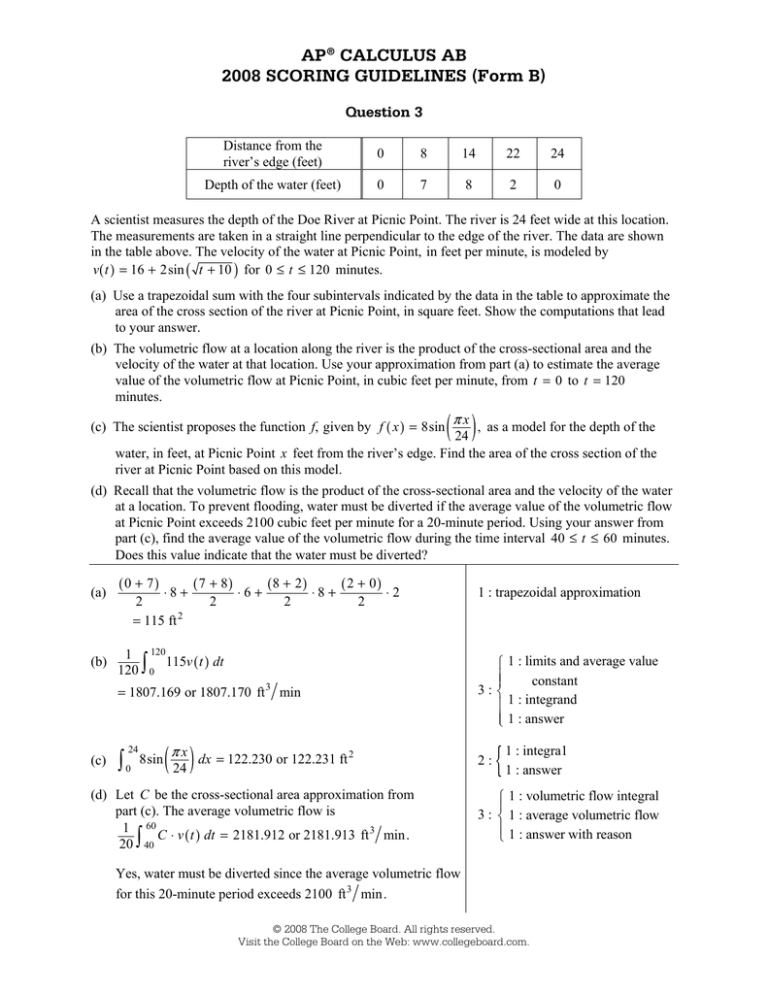
AP® CALCULUS AB
2008 SCORING GUIDELINES (Form B)
Question 3
Distance from the
river’s edge (feet)
0
8
14
22
24
Depth of the water (feet)
0
7
8
2
0
A scientist measures the depth of the Doe River at Picnic Point. The river is 24 feet wide at this location.
The measurements are taken in a straight line perpendicular to the edge of the river. The data are shown
in the table above. The velocity of the water at Picnic Point, in feet per minute, is modeled by
v( t ) = 16 + 2sin ( t + 10 ) for 0 ≤ t ≤ 120 minutes.
(a) Use a trapezoidal sum with the four subintervals indicated by the data in the table to approximate the
area of the cross section of the river at Picnic Point, in square feet. Show the computations that lead
to your answer.
(b) The volumetric flow at a location along the river is the product of the cross-sectional area and the
velocity of the water at that location. Use your approximation from part (a) to estimate the average
value of the volumetric flow at Picnic Point, in cubic feet per minute, from t = 0 to t = 120
minutes.
(c) The scientist proposes the function f, given by f ( x ) = 8sin
( π24x ) , as a model for the depth of the
water, in feet, at Picnic Point x feet from the river’s edge. Find the area of the cross section of the
river at Picnic Point based on this model.
(d) Recall that the volumetric flow is the product of the cross-sectional area and the velocity of the water
at a location. To prevent flooding, water must be diverted if the average value of the volumetric flow
at Picnic Point exceeds 2100 cubic feet per minute for a 20-minute period. Using your answer from
part (c), find the average value of the volumetric flow during the time interval 40 ≤ t ≤ 60 minutes.
Does this value indicate that the water must be diverted?
(a)
(b)
(0 + 7)
⋅8 +
2
= 115 ft 2
( 7 + 8)
2
⋅6+
(8 + 2 )
2
⋅8 +
( 2 + 0)
2
⋅2
1 120
115v ( t ) dt
120 ∫ 0
⎧ 1 : limits and average value
⎪⎪
constant
3: ⎨
⎪ 1 : integrand
⎩⎪ 1 : answer
= 1807.169 or 1807.170 ft 3 min
24
(c)
∫0
8sin
( π24x ) dx = 122.230 or 122.231 ft
1 : trapezoidal approximation
2
(d) Let C be the cross-sectional area approximation from
part (c). The average volumetric flow is
1 60
C ⋅ v ( t ) dt = 2181.912 or 2181.913 ft 3 min.
20 40
∫
2:
{
1 : integra1
1 : answer
⎧ 1 : volumetric flow integral
⎪
3 : ⎨ 1 : average volumetric flow
⎪⎩ 1 : answer with reason
Yes, water must be diverted since the average volumetric flow
for this 20-minute period exceeds 2100 ft 3 min.
© 2008 The College Board. All rights reserved.
Visit the College Board on the Web: www.collegeboard.com.
©2008 The College Board. All rights reserved.
Visit the College Board on the Web: www.collegeboard.com.
©2008 The College Board. All rights reserved.
Visit the College Board on the Web: www.collegeboard.com.
©2008 The College Board. All rights reserved.
Visit the College Board on the Web: www.collegeboard.com.
©2008 The College Board. All rights reserved.
Visit the College Board on the Web: www.collegeboard.com.
©2008 The College Board. All rights reserved.
Visit the College Board on the Web: www.collegeboard.com.
©2008 The College Board. All rights reserved.
Visit the College Board on the Web: www.collegeboard.com.
AP® CALCULUS AB
2008 SCORING COMMENTARY (Form B)
Question 3
Sample: 3A
Score: 9
The student earned all 9 points.
Sample: 3B
Score: 6
The student earned 6 points: 1 point in part (a), no points in part (b), 2 points in part (c), and 3 points in part (d).
The student presents correct work in parts (a), (c), and (d). In part (b) the student does not produce an integral,
which is needed in order to find the average value of volumetric flow.
Sample: 3C
Score: 3
The student earned 3 points: 1 point in part (a), no points in part (b), 2 points in part (c), and no points in part (d).
The student presents correct work in parts (a) and (c). In part (b) the student does not produce an integral to find
the average value and thus did not earn any points. In part (d) the student also does not produce an integral and
did not earn any points. Although the student’s statement that the water “must be diverted” is true, the student
does not present enough correct calculus work leading up to the answer to earn the answer point.
© 2008 The College Board. All rights reserved.
Visit the College Board on the Web: www.collegeboard.com.


